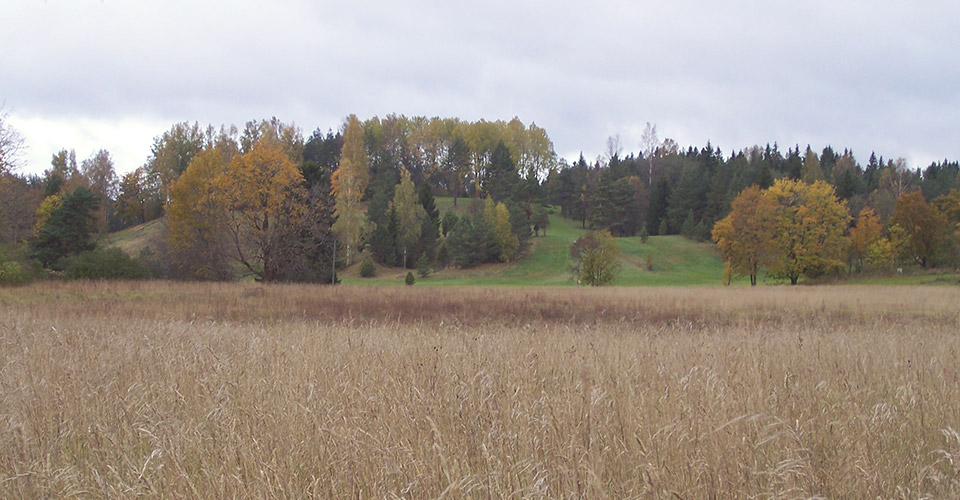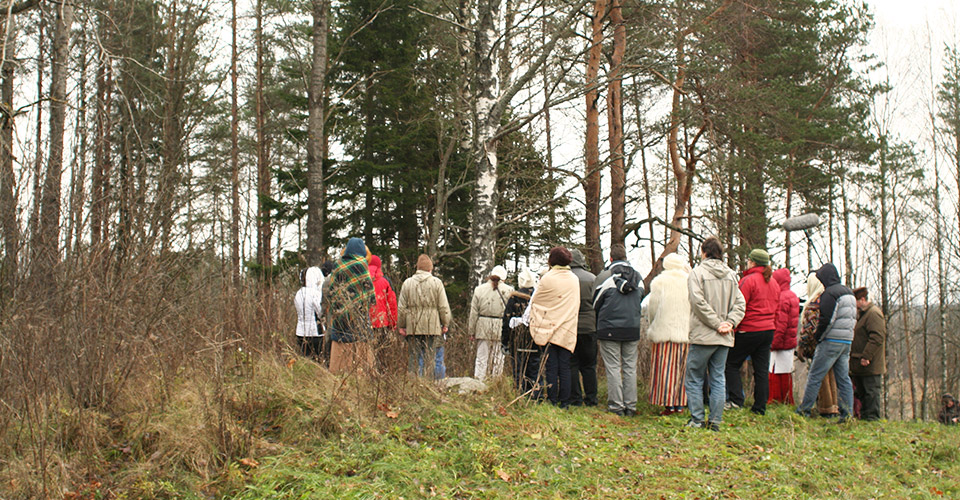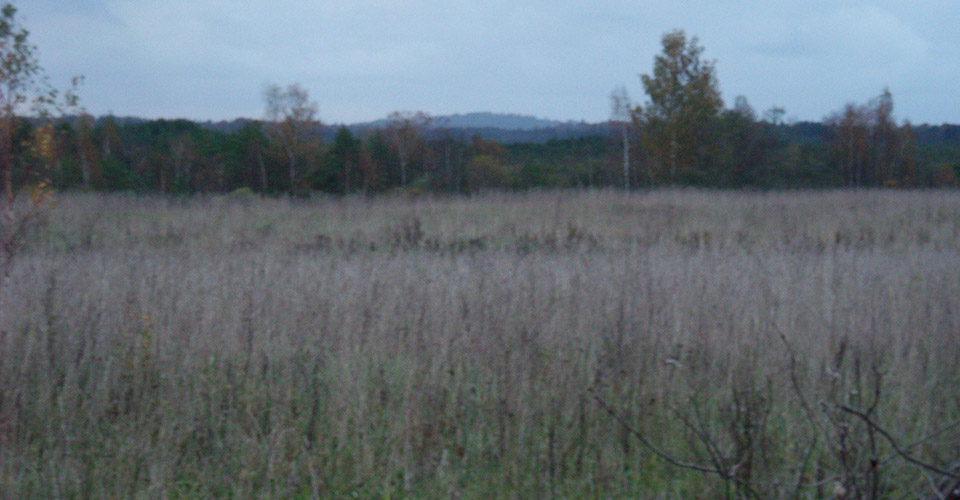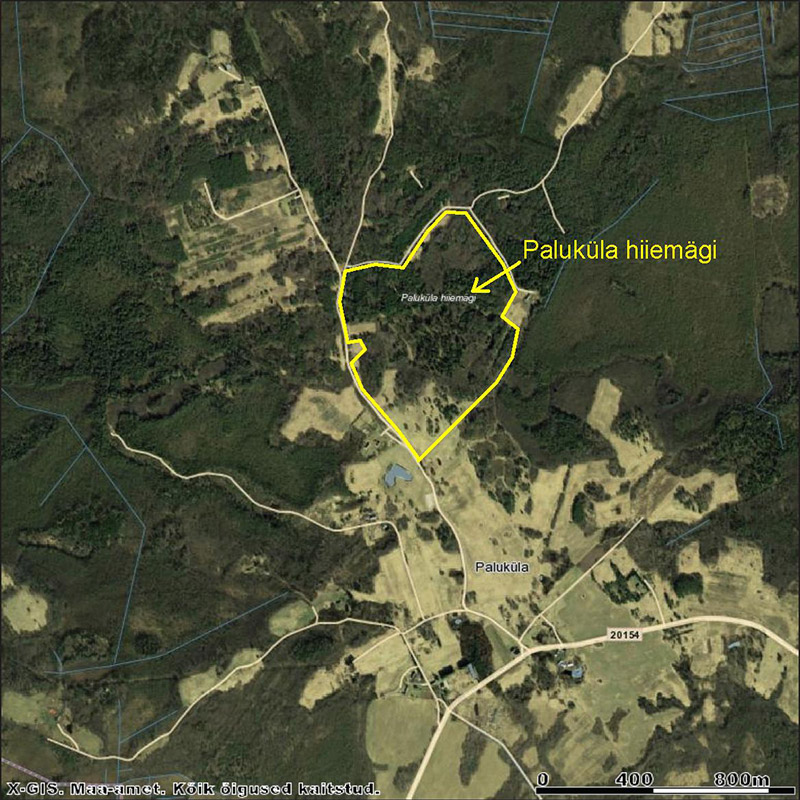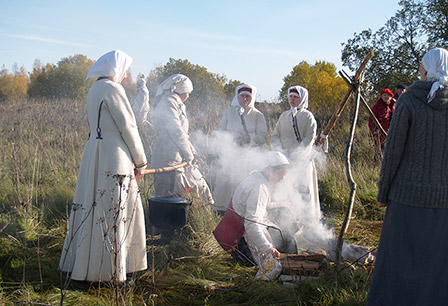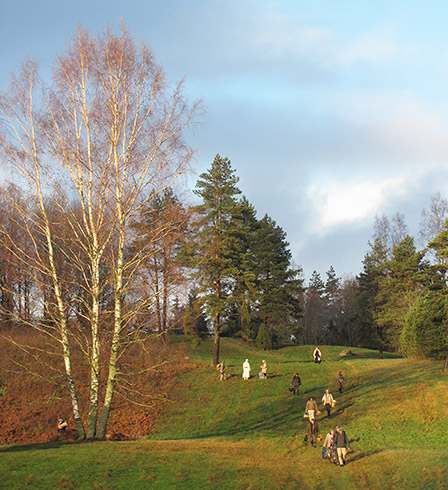사이트
13 세기 리비니아 십자군에서 독일인과 덴마크 인에 의한 에스토니아의 정복과 기독교 화 전에, 모든 지역 마을은 신성한 자연 유적지를 공유했습니다. 많은 지역 마을 사람들은이 시대부터 데이트를하고 그들의 신성한 자연 유적지가 풍경에서 패턴을 형성합니다.. 중앙 에스토니아 Paluküla 마을 영역에서 Hiiemägi라는 신성한 포레스트 힐을 낳는다 ("이들-언덕 "). 수많은 지역 사람들이 여전히 Maausk를 따릅니다, 그들은 자연을 신성으로 숭배한다는 것을 의미합니다. 그들은 올해의 첫 번째 수확을 Hiiemägi와 나무와 관련된 조상들에게 제공합니다.. 그들은 또한이 사이트에서 한여름의 날을 축하합니다. 전통에 따르면, 나무는 자르지 말고 언덕을 쟁기질하거나 방해 할 수 없습니다..
생태와 생물 다양성
언덕은 유역 지역의 일부를 형성합니다. 그것은 다양한 작은 힙과 계곡으로 구성되며 가장 두드러진 지점입니다. Paluküla 자체는 Moraine과 Kame Field. 언덕의 대부분은 숲으로 덮여 있습니다. 산림 서식지 유형에는 Fennoscandian 허브가 풍부한 숲이 포함됩니다 Picea Abies 서부 타이가. 에스토니아 환경 레지스트리는 흰색의 딱따구리를 포함한 보호 된 산림 조류 종을보고합니다. Dendrocopos Leucotos, 박쥐 종과 붉은 나무 개미 인구 (Formica polyctena).
위협
거의 모든 마을 사람들은 언덕이 그들에게 중요하다고하지만, 어떤 사람들은 토지 사용의 상용화로 외부로부터의 영향에 의해 분할된다, 건물 및 개발 가능한 EU의 간섭. Kehtna 지방 자치 단체의 관리는 언덕 한쪽에 스포츠 및 레크리에이션 센터를 건설 할 예정입니다.. 직계 이웃은 일상 생활을 바꿀 제안 된 프로젝트에 의해 방해받습니다.. 센터의 상세한 공간 계획에 따르면, 인공 스노우 대포를위한 두 개의 스키 리프트와 워터 파이프는 발굴이 필요합니다.. 게다가, 20 개의 건물, 또한 주차 공간; 배구 광장, 두 개의 테니스 코트와 축구 경기장이 사이트 옆에 계획되었습니다., 자연 보존 지역 내의 모든 것.
Custodians
Maausk의 추종자들은 정기적으로 사이트에서 개인 및 공동 의식을 수행합니다.. 그들은 전통적으로 목재와 농업 관행의 현지 금지로 신성한 자연 유적지를 보호했습니다.. 그들은 성스러운 언덕을 계속 존중하고 일부는 Paluküla 신성한 포레스트 힐을 보호하기 위해 협회. 협회는 언덕의 후견인 역할을하고 연구하고 보존 신성한 사이트 및 다른 조직과 의사 소통을하는 것을 목표로. 토착 지역 자연 종교를위한 지원 조직, ‘Taara의 에스토니아어 하우스와 원주민 종교‘종교 단체로 등록되었습니다. ‘집’은 에스토니아 전역의 신성한 자연 유적지를 보호하고 활성화합니다..
시력
관리인 운동은 산림 절단 및 건축 계획으로부터 Hieemägi와 같은 신성한 자연 유적지를 보호하고 보존하기 위해 노력하고 있습니다.. 에스토니아에 걸쳐 신성한 자연의 사이트는 보호되어야하고, 자연과 문화 유산의 관리에 관계하는 기관은 관리인에 의해 보존 노력을 지원하기 위해 장착해야.
이 특별한 장소, 인간의 활동이 자연에 지배하지 않는 곳, 자연과 문화 유산을 결합하는 동시에 신성한 차원이. Paluküla이 경우, 반 개방 남쪽 언덕은 당분간 겨울에 슬라이딩에 사용될 수 있습니다, 그러나 인공 구조물이없는. 이 사이트는 또한 자연 교육 생활 예를 들어 역할을 할 수 있습니다, 폭 넓은 관객들에게 문화 보존 사례를 소개.
연합
현지 관리인은 처음으로 타라 라와 원주민 종교와 처음 접촉했습니다.. 이웃 핀란드의 유사 조직, 천국, 언덕을 지원하는 서명을 수집했습니다; Finno-Ugric 사람들은 비슷한 신성한 자연 장소와 해당 전통을 가지고 있습니다.. 자연을위한 에스토니아 기금. 비정부 조직, 에스토니아 그린, 그들의 사건을 포함시켰다 자연 보호에 관한 인터뷰서 에스토니아에서.
아메리카 원주민, 에스토니아 방문시, 신성한 자연 유적지를 지원하기 위해 현장에서 의식이있었습니다.. 일부 생물 학자, 민속 학자, 그리고 고고학자들은 그들의 전문 지식으로 사건을지지합니다.
행동
11 월 8 일 2004, "Foggy Souls 'Time"으로 알려진 기간 내에, 언덕에있는 사람들의 모임은 불도저를 막고 대중과 언론의 관심을 끌 수있었습니다.. 에스토니아 전역의 서명은 청원을 위해 수집되었습니다.. 현지 관리인은 겨울 스포츠 센터에 대한 상세한 공간 계획과 스카이 리프트를 포함한 법원 사건을 시작했습니다.. 건설 허가가 철회되었습니다, 그러나 계획은 잊혀지지 않았습니다. 이 사건은 이제 유럽 인권 재판소의 권위 아래 있습니다.. 현지 관리인은 예비 건설 허가를 계속 지켜보고 필요할 때 여전히 도전합니다..
보호 도구
‘번역IUCN 유네스코 신성한 자연 유적지: 보호 지역 관리자를위한 가이드라인‘에스토니아어로 2011 환경위원회의 지역 사무실 에서이 책의 후속 도입, 계획 프로세스에서 신성한 자연 사이트를 고려할 수있게되었습니다.. Kehtna 지방 자치 단체의 새로운 일반 계획은 신성한 자연 사이트를 언급하고 건축에 해를 끼치 지 않습니다..
정책 및 법률
Hiiemägi는 타고난에서 Kõnnumaa 자연 보존 지역으로 보호 2000 네트워크. 에스토니아 법은 신성한 자연의 사이트를 인식하지 못합니다, 보호로하지만, 고고학 및 자연 경관을 인식 않습니다. 초안 법률은 의회, 문화 유산 보존 행위와 에스토니아의 자연 보호 법률을 모두 개정하는. 신성한 자연의 사이트는 기념물의 특별한 유형으로 볼 수 있어야합니다, 보호의 대응 규칙.
결과
언덕은 그대로 남아 있습니다; 숲은 잘리지 않습니다. 보호와 다른 종들은 여전히 그들의 서식지에 살고 있습니다. 사람들의 회의, 오래된 원주민 전통과 민속 캘린더의 휴일을 축하합니다.. 의식 화재는 전통적인 벽난로에서 이루어지고 모든 이해 관계자들은 언덕의 신성함을 점점 더 많이 고려합니다.. 관리인은 이제 국제 연락처와 국가를 가지고 있습니다 신성한 자연 유적지에 대한 보존 계획 2008-2012 년 에스토니아에서는 부분적으로 구현되었습니다. 사이트 인벤토리에 대한 현장 작업이 시작되었습니다.
구두 유산, Paluküla에서 작성했습니다 1937:
"또 다른 사례. 제물 돌을 둘러싼 나무가 거룩했기 때문에 나쁘다는 것을 의미했습니다.. 그리고 예측이 이루어졌습니다. 올해 많은 소가 마을에서 죽었다."
- 에스토니아 민속 기록 보관소 시대 i 5, 723 (2)
- 에스토니아. 2008. 에스토니아 역사적인 자연 보호 구역. 조사와 보류, 지역 개발 계획 2008-2012. 탈린. 보존 계획 "에스토니아의 신성한 자연 유적지: 연구 및 유지 2008 - 2012"
- 이빨, 케이, 9 월, A. 2006. Paluküla Hiiemäe 저축 사회, 에: 환경과 시민 이니셔티브: 고향을 들고있는 사람들과의 인터뷰 (환경 및 시민 이니셔티브: 인터뷰) 에스토니아 녹색 운동, 2006 PP. 25-30.
- 경기, R. 그리고 mcleod, C. (2008) ‘신성한 자연 사이트. 보호 지역 관리자를위한 가이드라인', 모범 사례 보호 구역 가이드 라인 시리즈 No16, 글 랜드, 스위스, IUCN.
- 조크스, 티. 2012. Rapla와 Juuru의 교구에서 Hiissis. 에스토니아 고고학 저널, 보충, 집. 1, PP. 168–183.
- 사람, A. 2011. 에스토니아의 신성한 자연 유적지 보존, 에: Mallarach, J-M; PAPAYANNIS, 티. & vaisen, R. (EDS.) 유럽의 신성한 땅의 다양성. 델로스 이니셔티브의 두 번째 워크숍 절차, 2010. IUCN & 임학. 핀란드.
- 사냥꾼, A. 현대 통치의 맥락에서 에스토니아 신성한 자연 유적지의 다양성. 신성한 보호 회의에 대한 요약: 북부 및 북극 지역에서 자연과 문화를 유지하기위한 원주민의 신성한 유적지 인식 Rovaniemi와 Pyhä, 핀란드, 11-13 9월 2013.
- 9 월, A. 2011. "어떤 신성한 자연의 사이트이며 왜 당신에게 중요하다?"
- 9 월, A. 2012. 에스토니아의 자연 성소에 대한 국가 계획 - 2008–2012: 도전과 관점, 에: Mallarach, J-M (와.) 유럽 워크숍 절차의 보호 지역의 영적 가치 - vilm의 섬, 2ND – 6 일 11 월 2011. BFN 스크립트 322 2012, PP. 149-155.
- Paluküla의 신성한 숲 언덕을 보호하기위한 협회: http://palukyla.maavald.ee/
- Taara의 에스토니아어 하우스와 원주민 종교: http://www.maavald.ee/eng/
- 핀란드에서 성스러운 자연 유적지를 공부하는 NGO: http://www.taivaannaula.org/in-english/ | http://www.taivaannaula.org/2012/11/palukylan-hiidenmaella/
- 에스커의 사슬, 카메 필드와 작은 드럼 린: http://www.estonica.org/en/Nature/Transitional_Estonia/Chains_of_eskers,_kame_fields_and_small_drumlins
- 인디언과 원주민 에스토니아 인의 숭배: HTTP://tiny.cc/tsxj9w
- 에스토니아 의회. 대리인 협회와 노조: 자연 성소 지원 그룹 | http://www.riigikogu.ee/index.php?id=34605

